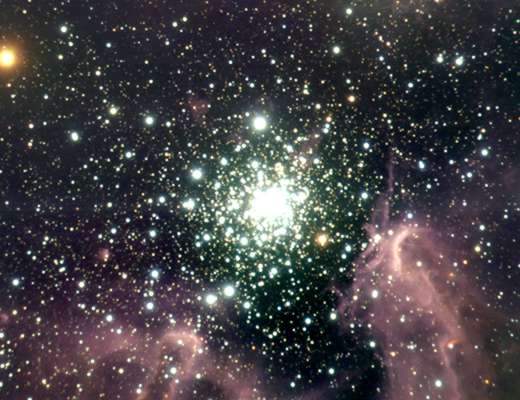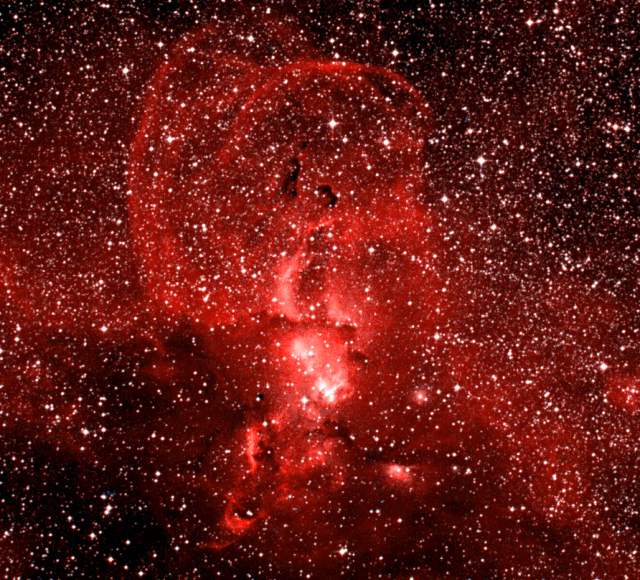
NGC 3576-79-81-82-84-86. Image size: 0.50°x0.45°. DSS image. © AAO/ROE
This nebula is a minor nebula in the Sagittarius arm of the Galaxy a few thousand light years from the Eta Carinae nebula. When John Herschel discovered this nebula in 1834 he could only see several bright nebulous patches and eventually this nebula received six separate classification numbers. These days astronomers usually call the entire nebula NGC 3576.

This is a list of the nebulae in this region. These are the six patches of the nebula which were classified in the nineteenth century. The entire nebula extends across about one degree of the sky and it has a diameter of about 100 light years. Also included in this list is the much more distant NGC 3603 nebula which is in the same area of the sky; this nebula is only the brightest part of an enormous nebulous region which probably extends over 1000 light years of space.
1 2 3 4 5 6 7 8
Catalogue Equatorial Galactic Size Type Distance Size Other Names
Number Coordinates Coordinates (arcmins) (ly) (ly)
RA (2000) Dec l° b°
--------------------------------------------------------------------------------------
NGC 3576 11 11.5 -61 22 291.3 -0.8 2' E 6000 3
NGC 3579 11 12.0 -61 15 291.3 -0.7 3' E 6000 5
NGC 3581 11 12.0 -61 18 291.3 -0.7 3' E 6000 5
NGC 3582 11 12.2 -61 16 291.3 -0.7 3' E 6000 5
NGC 3584 11 12.3 -61 14 291.3 -0.6 3' E 6000 5
NGC 3586 11 12.5 -61 21 291.4 -0.7 2' E 6000 3
NGC 3603 11 15.1 -61 16 291.6 -0.5 20' E 20000 120
|
Column 1: The standard catalogue name for the nebula. Column 2: Right Ascension and Declination for epoch 2000. Column 3: Galactic Longitude (l) and Latitude (b). Column 4: Angular size of the nebula in arcminutes. Column 5: Nebula type: E = emission, R = reflection. Column 6: Approximate distance to the nebula. Column 7: Approximate size of the nebula in light years. Column 8: Alternative name of the nebula.
These are the star clusters which are close to the NGC 3576 nebula. These clusters are to the north of NGC 3576 but many of them may be associated with the nebula. Also added to the bottom of the list is the NGC 3603 cluster which is a very young cluster 20000 light years away.
1 2 3 4 5 6 7
Catalogue Equatorial Galactic Size Distance Age Other Names
Name Coordinates Coordinates (arcmins) (ly) (million
RA (2000) Dec l° b° years)
-------------------------------------------------------------------------------
NGC 3572 11 10.4 -60 15 290.7 +0.2 5' 6500 8
Hogg 10 11 10.8 -60 24 290.8 +0.1 3' 5800 6
Trumpler 18 11 11.5 -60 40 291.0 -0.1 5' 4450 16
Hogg 11 11 11.7 -60 24 290.9 +0.1 2' 7400 12
Collinder 240 11 11.7 -60 19 290.9 +0.2 20' 5150 14
NGC 3590 11 13.0 -60 47 291.2 -0.2 3' 5400 17
NGC 3603 11 15.2 -61 16 291.6 -0.5 1' 20000 1
|
Column 1: The standard catalogue name for the cluster.
Column 2: Right Ascension and Declination for epoch 2000.
Column 3: Galactic Longitude (l) and Latitude (b).
Column 4: Angular size of the cluster in arcminutes.
Column 5: Distance to the cluster.
Column 6: Approximate age of the cluster in millions of years.
Column 7: Alternative name of the cluster.
References:
Dias W, Alessi B, Moitinho A, Lépine J, (2002). New catalogue of optically
visible open clusters and candidates. Astron and Astrophys, 389, 871.
Pandey A, Ogura K, Sekiguchi K, (2000), Stellar Contents of the Galactic
Giant HII Region NGC 3603, Publ. Astron. Soc. Japan, 52, 847.
This map shows the location of the NGC 3576 nebula in the sky. NGC 3576, 3579, 3581, 3582, 3584 and 3586 are all bright patches in the centre of the nebula. To the north of the NGC 3576 region are several star clusters which are probably quite close to the nebula. The region to the left of NGC 3576 is the completely separate NGC 3603 nebula. This nebula is about 14000 light years behind NGC 3576.
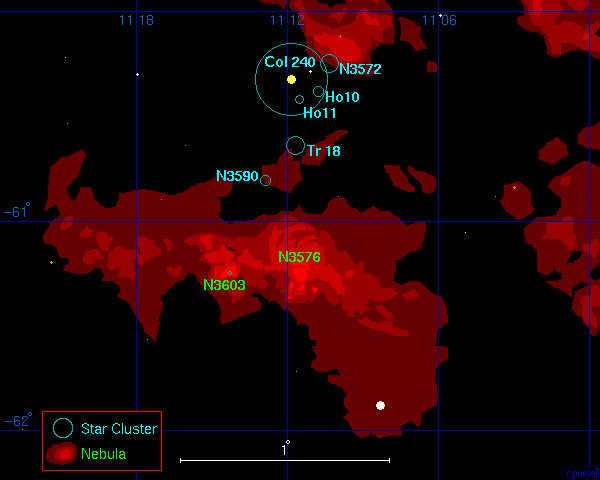
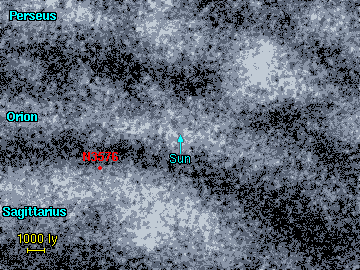
|
The distance to the NGC 3576 nebula is not known very precisely, but it definitely lies near the front edge of the Sagittarius Arm. If we assume that the nearby star clusters are associated with the nebula, then it is probably about 6000 light years away. |
Bok Globules in NGC 3576In the north of the nebula are these two dark nebulae. They both have a diameter of about 2 light years, and they are dense concentrations of gas and dust (although if you were inside one it would still seem like a perfect vacuum). These types of small dark nebulae are known as "Bok Globules" (named after Bart Bok who studied many examples) and many of them contain stars in the process of forming. These globules are about 1000 times the diameter of our solar system. |
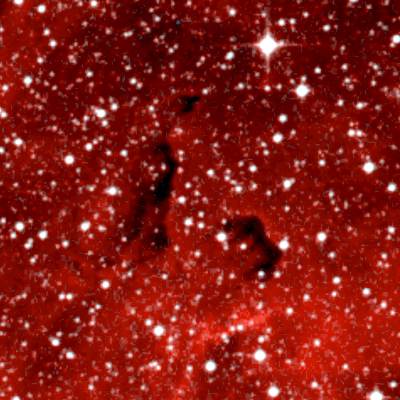 Globules in NGC 3576. Image size: 0.11°x0.11°. |
West of NGC 3576 is a much more distant nebula. Although it is very obscured, the bright central part of this nebula is visible to us. This nebula may be one of the largest nebulae in the entire Galaxy (it is an example of a "giant HII region"). To astronomers in other nearby galaxies it would be a visible as a bright pink spot on the Sagittarius Arm. This picture shows the bright central region of this nebula which contains a very compact and very young cluster of stars.
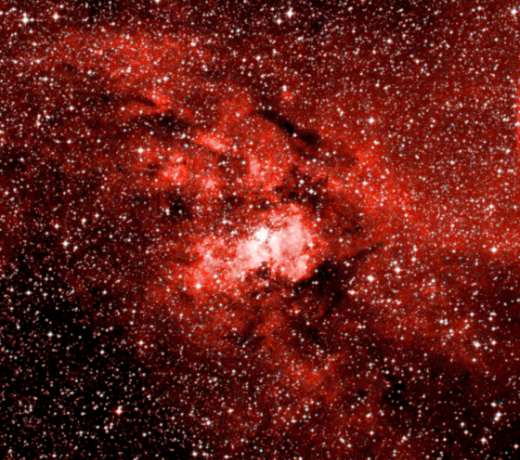
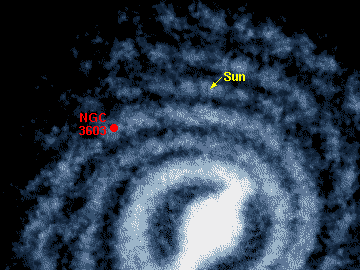
|
The distance to NGC 3603 is estimated to be about 20000 light years from us. Estimates of it's total size vary but it is certainly over 1000 light years in diameter and it could be nearly 2000 light years in diameter. |
Below is a picture of the NGC 3603 star cluster which lies in the middle of the nebula. This cluster is very young. Although some of the stars are several million years old, the average age for all the stars is less than 1 million years. This picture in an infra-red image from the Very Large Telescope.
